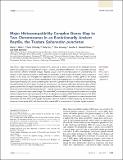Major Histocompatibility Complex Genes Map to Two Chromosomes in an Evolutionarily Ancient Reptile, the Tuatara Sphenodon punctatus

View/
Author
Miller, Hilary C.
O’Meally, Denis
Ezaz, Tariq
Amemiya, Chris
Marshall-Graves, Jennifer A.
Published Version
https://doi.org/10.1534/g3.115.017467Metadata
Show full item recordCitation
Miller, Hilary C., Denis O’Meally, Tariq Ezaz, Chris Amemiya, Jennifer A. Marshall-Graves, and Scott Edwards. 2015. “Major Histocompatibility Complex Genes Map to Two Chromosomes in an Evolutionarily Ancient Reptile, the Tuatara Sphenodon punctatus.” G3: Genes|Genomes|Genetics 5 (7): 1439-1451. doi:10.1534/g3.115.017467. http://dx.doi.org/10.1534/g3.115.017467.Abstract
Major histocompatibility complex (MHC) genes are a central component of the vertebrate immune system and usually exist in a single genomic region. However, considerable differences in MHC organization and size exist between different vertebrate lineages. Reptiles occupy a key evolutionary position for understanding how variation in MHC structure evolved in vertebrates, but information on the structure of the MHC region in reptiles is limited. In this study, we investigate the organization and cytogenetic location of MHC genes in the tuatara (Sphenodon punctatus), the sole extant representative of the early-diverging reptilian order Rhynchocephalia. Sequencing and mapping of 12 clones containing class I and II MHC genes from a bacterial artificial chromosome library indicated that the core MHC region is located on chromosome 13q. However, duplication and translocation of MHC genes outside of the core region was evident, because additional class I MHC genes were located on chromosome 4p. We found a total of seven class I sequences and 11 class II β sequences, with evidence for duplication and pseudogenization of genes within the tuatara lineage. The tuatara MHC is characterized by high repeat content and low gene density compared with other species and we found no antigen processing or MHC framework genes on the MHC gene-containing clones. Our findings indicate substantial differences in MHC organization in tuatara compared with mammalian and avian MHCs and highlight the dynamic nature of the MHC. Further sequencing and annotation of tuatara and other reptile MHCs will determine if the tuatara MHC is representative of nonavian reptiles in general.Other Sources
http://www.ncbi.nlm.nih.gov/pmc/articles/PMC4502378/pdf/Terms of Use
This article is made available under the terms and conditions applicable to Other Posted Material, as set forth at http://nrs.harvard.edu/urn-3:HUL.InstRepos:dash.current.terms-of-use#LAACitable link to this page
http://nrs.harvard.edu/urn-3:HUL.InstRepos:17820743
Collections
- FAS Scholarly Articles [18258]
Contact administrator regarding this item (to report mistakes or request changes)


